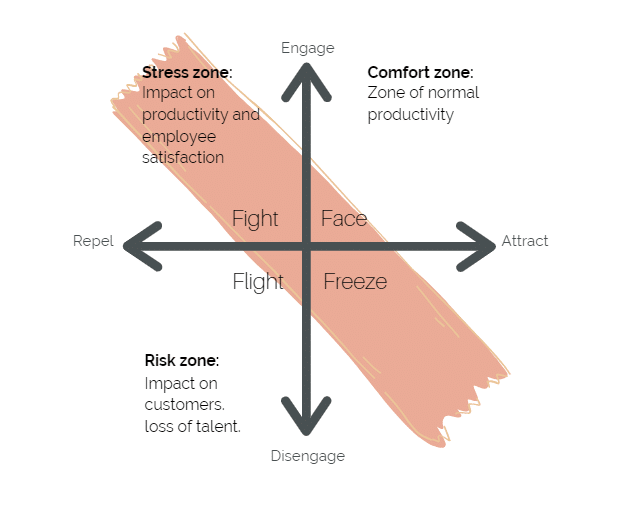Mindset continuum
Time estimate: 12 Minutes

Let me share a story with you. A man in the middle of his career found himself stressed and challenged by the organisation’s internal politics and interpersonal battles. In a conversation, I asked him to lift his arm into the high-five position. I then asked him to apply pressure against my palm and held the position. Then we repeated the exercise and I asked again for him to apply pressure. This time I just let my hand move along the way he pressed.
He reflected on that then said smiling: “I experience stress because I push and try to change the situation. If I choose to love it or leave it the conflict resolves.”
4-F Model

Human beings naturally react to danger and uncertainty with one of the 4 F’s: Fight, Flight, Freeze, or Face.
Whilst Fight and Freeze reactions could be symbolised by me holding or countering the pressure of the man’s high-five. Face and Flight reactions would equate to the lack of counter-pressure. Similar to the man in the story, employees feel stressed most when they freeze in reaction to or fight the changes.
From a leadership point of view, we want employees to face the organisational change to maintain operational productivity (Love it). Whilst facing the challenges of the organisational change is the desired outcome it is often not the easiest choice for employees to simply love what they don’t understand.
More likely we see employees resisting organisational change by action or argument. In conflict resolution we call these choices: Love it, Change it or Leave it. Inviting stakeholders to co-create and engage in the change activity enables them to impact and influence the course of action (Change it). Some employees will openly opt-out from the change by choosing Flight and leaving it. Whilst loss of talent is unfortunate, it is not always avoidable. The rate of avoidable voluntary turnover gives an indication of how well resistance is managed during a change.
Don’t react
A first step in resolving conflicts and managing resistance to change is to stay calm and remind yourself that this is a natural reaction in response to the threat of uncertainty rather than you as a person.
After taking 3 calming breaths take your time to observe and listen to what factual information is being given by the other; not how he or she says it. If you are not sure if you understood it correctly, make a commitment to clarify your understanding before responding.
Observe if your brain is telling you to…

- FIGHT:
Do you have an “I win – you lose” attitude?
Do you feel an urge to control, demand, bulldoze, punish, explode or manipulate (Conflict seeker)?
- FLIGHT or FREEZE:
Do you have an “I lose-you win”, or “I lose – you lose” attitude?
Do you feel an urge to submit, resign, withdraw, suppress or surrender (Conflict avoider)?
- FACE the situaion:
Do you have an “I win – you win” attitude?
Do you feel an urge to share power, unfold opportunity, consider, calm the situation or seek agreement?
Counteract your natural urge by focussing on your counterpart. Aim to face the conflict with optimism to achieve better outcomes for all parties. Although Win-Win solutions are not always possible, giving it a go is beneficial for the relationship and future outcomes.
Respond
Milliseconds of breaking your reaction pattern are valuable to cool down emotions and allow for your conflict resolution logic to kick in. Choose a response that achieves your “actual” goal for this conflict. Just like the man in our story, he didn’t want to win the interpersonal conflict negotiations, he wanted to lower his stress level. Winning debates is a sport that rarely leads to sustainable and superior outcomes. It’s better to aim for a fair or common goal to open negotiation with the chance of a win-win solution.
Sometimes knowing that you and your employees always have a choice to LOVE IT, CHANGE IT (directly or indirectly) or LEAVE IT can resolve resistance behaviour as it takes away the feeling of being a victim to a threat and losing control of the situation. This is particularly true if people feel trapped in status conflicts.

Although some conflicts simply resolve themselves as time passes by, not every conflict can be resolved. In that case, you might choose to reframe your mindset or help your employee to reframe theirs in order to embrace and love it. Use a pros-and-cons-list or a what’s-in-it-for-me-brainstorming (WIIFM) to do so.
These lists also help to actively address concerns and issues. In an active conflict resolution, it is important to re-state your counterpart’s opinion, your common goal, but signal that you have a different opinion. Try to brainstorm a solution together and present a second fair option that is more acceptable for you both.
If all other options fail or don’t seem to be right remind yourself that some conflicts cannot be resolved and it is best for you to exit. Try and make the Leave it option your last resort as it robs you of the opportunity to learn and grow.
Optional
Time estimate: 10 Minutes
This topic has additional resources in the Materials tab to deepen your understanding of breaking patterns of conflicts. At any point in time feel free to come back to this material.
Optional
Time estimate: 10 Minutes
This topic has additional resources in the Materials tab to deepen your understanding of breaking patterns of conflicts. At any point in time feel free to come back to this material.
